The first Yamato season is half way over. Right now, @zzings (1.5m reward points) is leading the race ahead of @powernap (1.4m reward points) and @dachcolony (0.9m reward points), but there is still a long way to go. So far, hunting Yamatos has not played a major role, but my guess is, that this will become a bigger theme towards the end of the season, when players which are falling behind running out of Stardust might potentially chose this strategy. But that is of course just my personal idea and it might turn out completely different.
One thing has been clear from the start – Stardust plays and important role in the Yamato race. Clearly, this is intentional as the Yamato seasons were designed in a way that they help to balance the game going forward. In order to participate in the Yamato race, players have the possibility to generate Stardust by selling ships and planets on the market, burning planets and doing explorations. All of this weakens their position going forward, so it is a tough decision when to sacrifice what. At the moment, there is additionally also the possibility to participate in the Stardust presale, which we will however most likely end rather sooner than later.
To make sure that the total Stardust supply is stable, we had implemented some additional Stardust sinks right ahead of the first Yamato season. The include a fee for our Buffs as well as a market fee. After the first season is now half way over, it is time to review how this has worked out so far:
Let’s start with the supply side first:
The most constant generator for Stardust is clearly explorations. Every exploration mission has a 10% chance to find a small amount of Stardust. Initially, we had set this amount to a random number between 10 and 300. This resulted in an average Stardust generation of roughly 130k per day until the 20th of November. We felt that this amount is somewhat too high, so we applied two changes: Firstly, we implemented the new mission control scheme, which now also limits the number of missions per planet. Secondly, we changed reduced the maximum Stardust amount which can be found in an exploration mission from 300 to 200. The consequence has been, that the average Stardust generation has gone down to roughly 70k per day.
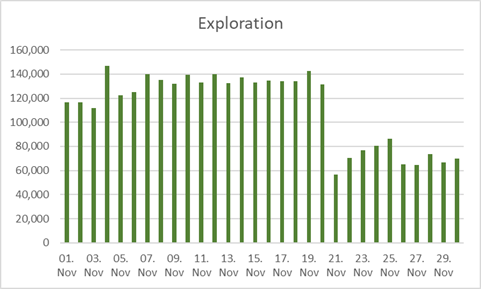
Stardust from shop purchases had originally been 100 Stardust per 1 Steem spent in the shop. This source of supply was stopped on the 24th of November, since then no more Stardust is generated from shop purchases. Until that day, the shop had on average added 90k Stardust per day to the supply.
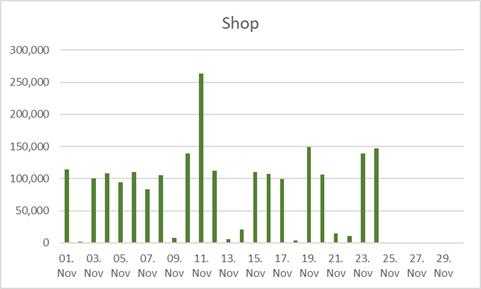
Finally, Stardust generation from burning planets started off slowly as players valued their planets. Until the Yamato season started on the 15th of November, the average Stardust generation from burned planets amounted to roughly 80k per day. This has increased step by step during the Yamato season, as some of the players, which try to win the season, have run out of stardust. During the season, the average Stardust generation from burned planets was 177k, but increased to roughly 800k the last two days.
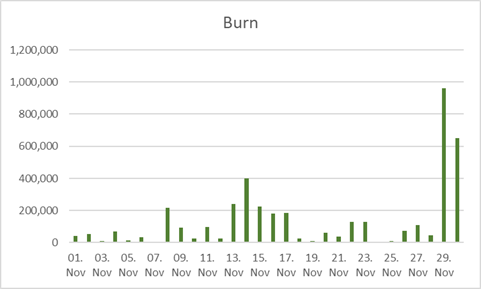
Altogether, the average Stardust generation was 328k per day so far in the Yamato season.
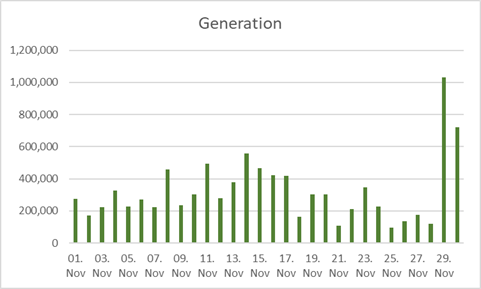
Coming to the consumption of Stardust:
The steadiest consumer of Stardust has so far been the market fees, including the market place fee, which on @jarunik’s marketplace is sent to @null. This has been around 70k per day and has not changed from before the season.
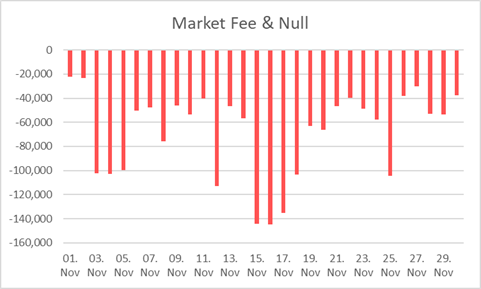
Buffs were a new sink, which we introduced only on the 23rd of November. Since then, it consumed on average 32k Stardust per day. Over time, we would expect this number to increase as we will add further buffs going forward.
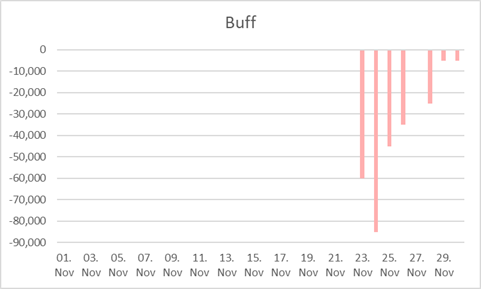
By far the biggest consumer of Stardust was however – as expected – the upgrades of Yamatos. Within the first 15 days, about 5.2m Stardust have been consumed by Yamato upgrade, which is roughly 600k per day. This number has increased significantly over time as Yamatos have come to the higher level, which makes upgrades much more costly. During the last two days of November, more than 1m Stardust was spent on Yamato upgrades and we would expect this number to stay high also over the rest of the season.
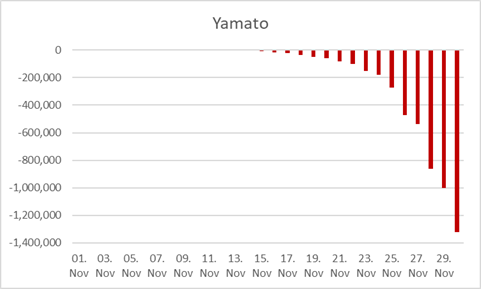
Overall, on average 413k Stardust per day were consumed so far during the first half of the Yamato season.
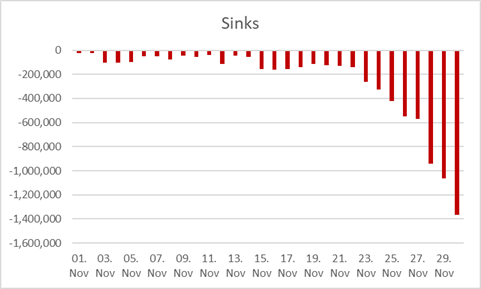
Adding this all up, we can see that organically Stardust is currently in deflationary territory. On average, the Stardust supply declined by 85k per day or 1.4m in total during the first 15 days of Yamato Season 1.
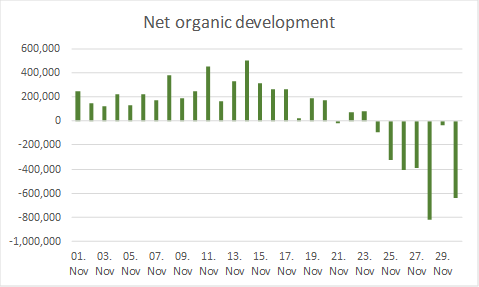
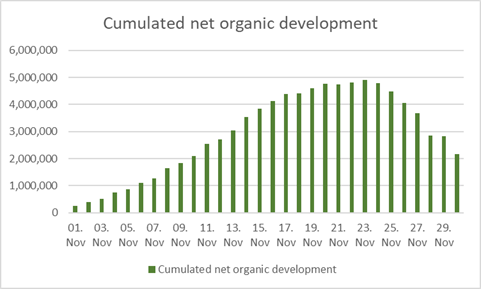
This organic development has been more than compensated by an additional supply of 10.3m Stardust, but as this is only a limited offer which will most likely ended rather sooner than later, this is clearly not the component which I would worry about.
Overall, I am more than happy with the development and I am rather sure, that the Stardust deflation will continue also during the second half of the season. Going forward, we will introduce further sinks, which should help to keep the Stardust economy stable.
Good luck with the second half of the season!
Tim
I love statistics, thank you for you diligence Tim :)
Downvoting a post can decrease pending rewards and make it less visible. Common reasons:
Submit
Welcome Robert
Downvoting a post can decrease pending rewards and make it less visible. Common reasons:
Submit
Great analysis man. Found this post and read another 2 of yours. Following you for more info. As for this: https://steemit.com/palnet/@rondras/how-did-the-early-whales-get-their-massive-amounts-of-steem-power-d the reason could be because STEEM had something like a 100% inflation in the early days with n^2 curve.
Downvoting a post can decrease pending rewards and make it less visible. Common reasons:
Submit
Thank you @d-zero. Its been a while since I wrote the Steem whale post, but I think that this does not explain the effect - inflation must have been much higher if that was the reason. I still wonder how it is possible that apparently nobody has an explanation for this...
Downvoting a post can decrease pending rewards and make it less visible. Common reasons:
Submit
You should try dropping the questionin comments when @steemitblog post something next.
Downvoting a post can decrease pending rewards and make it less visible. Common reasons:
Submit
Very cool analysis!
However doesn't this ignore the Stardust contained within the planets that are being discovered each day? There were around 65 planets discovered yesterday so this is probably something like 1million Stardust added to the supply each day.
My guess is that when the Steem vs Stardust market pair is fully established, many people will "cash-in" their planets, and the Stardust price will come under heavy selling pressure.
Stardust in planets is a little like "powered up" Steem, in that you need planets to participate in the game, just like you need Steem Power to participate in voting.
In order to stabilise the Stardust price it may be worth adding a delay to the "powering down" of planets, so that the Stardust produced from planet-burning is released over a period of time (like Steem Power powerdown).
This would also require players to think more tactically in relation to Yamato upgrading which can currently be funded simply by burning planets. Players would need to either burn planets before the season - harming their own development - or ensure they maintain other supply lines of Stardust throughout the season - with the risk that it is not available when they most need it. This may also make players hoard Stardust, decreasing its supply on the market.
Downvoting a post can decrease pending rewards and make it less visible. Common reasons:
Submit
You could think like this, and you should if the rules would be fixed. However, this does not work like a smart contract and rules can and will be changed. If the amount of Stardust inflation from burning planets would go up too much, we could react and decrease the amount of Stardust from burning planets. We have fixed the amount at a level, which makes economically not very viable to burn too many - but if it becomes necessary we would adjust these levels.
Downvoting a post can decrease pending rewards and make it less visible. Common reasons:
Submit
What a beautiful analysis! thanks for that nice piece of content, Tim!
Downvoting a post can decrease pending rewards and make it less visible. Common reasons:
Submit
I agree Oli! Now I can see why you are finding the Season so exciting! (: Seeing these numbers adds much more flavor to the bigger Yamato picture! ;D
Downvoting a post can decrease pending rewards and make it less visible. Common reasons:
Submit
Yeah, Stardust and Yamato harmonize pretty nice.
Downvoting a post can decrease pending rewards and make it less visible. Common reasons:
Submit
Thank you Oli!
Downvoting a post can decrease pending rewards and make it less visible. Common reasons:
Submit
The game steady advances and even if it is not as thrilling as some other ones are, I still believe in a bright future for it. It just needs some adrenaline to get more colonists rather than a lining increase.
Downvoting a post can decrease pending rewards and make it less visible. Common reasons:
Submit
interesting
Downvoting a post can decrease pending rewards and make it less visible. Common reasons:
Submit
Analysis is always good - deserves resteem and full vote . Given time constraints and lacking support of services I pay for my chances here are extremely low. But I appreciate what you did with this game - personally I need some amendments on usability for users with no time. Happy to chat directly
Posted using Partiko Android
Downvoting a post can decrease pending rewards and make it less visible. Common reasons:
Submit
Always happy to chat with you Uwe!
Downvoting a post can decrease pending rewards and make it less visible. Common reasons:
Submit
I know - thanks buddy - if i only had time to chat.
Downvoting a post can decrease pending rewards and make it less visible. Common reasons:
Submit
So the amount of sd the people used to upgrade Yamatos so far is already more then the amount that is in the price pool (also using all the steem to buy SD).
The other point I see in this season is that the people are using evrything they have because they will quit after the season.
Posted using Partiko Android
Downvoting a post can decrease pending rewards and make it less visible. Common reasons:
Submit
Rewards are redefined each season. We still have to learn, that's the first season.
Downvoting a post can decrease pending rewards and make it less visible. Common reasons:
Submit
This is one aspect also, but I think that this is only one or two players
Downvoting a post can decrease pending rewards and make it less visible. Common reasons:
Submit
This was a point for me that was clear since the begining of the season, this is also why I didn't participated in it.
Downvoting a post can decrease pending rewards and make it less visible. Common reasons:
Submit
Adjusting the internal economics of the game is good but going forward I think that a top priority should be to make the game more dinamic by fixing the response times.
I mean sometimes when you do an upgrade or start a mission it can take a long time or there is no response from the server/node. That UX is not good if you want to make the game appealing to a wider audience.
Maybe group upgrades in a single custom json, that should help with the server load and reduce the bloat to the blockchain.
Downvoting a post can decrease pending rewards and make it less visible. Common reasons:
Submit
Have you tried out @jaruniks client? He has done this quite well I think - although he also has no group upgrades. Also crypt riddler's tool is very cool for building upgrading. Generally, I am with you, there is still room for improvement in UX, but I think that we are indeed developing in the right direction - and that motivates users with their own tools also add great value to the UX!
Downvoting a post can decrease pending rewards and make it less visible. Common reasons:
Submit
I have tried jarunik's client but I find it unintuitive and not much better UX wise. Thanks for letting me know about crypto riddler's tool I will check it out.
Downvoting a post can decrease pending rewards and make it less visible. Common reasons:
Submit
@tipu curate
Downvoting a post can decrease pending rewards and make it less visible. Common reasons:
Submit
Upvoted 👌 (Mana: 0/10 - need recharge?)
Downvoting a post can decrease pending rewards and make it less visible. Common reasons:
Submit
Thank you
Downvoting a post can decrease pending rewards and make it less visible. Common reasons:
Submit
Frankly speaking, exploration is not adding stardust for me. I lost more explorers (one time they are priced around 300 SD, recent yamato module hit the ship price hard.) then the stardust I found through the exploration.
If I remove the one planet that I found through exploration, I am net negative .
Finding the planet is luck but I think finding stardust should not be luck. You can come up with calculation how the 70K SD can be distributed to all exploration ranging from 10SD to 100 SD.
Downvoting a post can decrease pending rewards and make it less visible. Common reasons:
Submit
The chance to find Stardust is relatively high at 10% - so this will normally be relatively reliable to calculate I would think. On average, you should find 2x Stardust before the explorer is lost, which should bring you on average 310 Stardust. You can be lucky or unlucky of course, but this is much less relevant compared to finding planets.
Downvoting a post can decrease pending rewards and make it less visible. Common reasons:
Submit
Analysis is never an easy task. But you Succeeded. Great work
Posted using Partiko Android
Downvoting a post can decrease pending rewards and make it less visible. Common reasons:
Submit
very good,
I hope you can see my blog so I can be enthusiastic about working. thank you ,,
Downvoting a post can decrease pending rewards and make it less visible. Common reasons:
Submit
Congratulations @rondras! You received a personal award!
You can view your badges on your Steem Board and compare to others on the Steem Ranking
Vote for @Steemitboard as a witness to get one more award and increased upvotes!
Downvoting a post can decrease pending rewards and make it less visible. Common reasons:
Submit